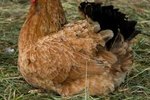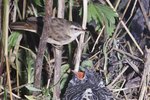
The person who coined the adage, "It takes a village to raise a child," might have been observing flamingos. For this species, it takes a colony to raise the young. However, flamingo parents are in charge of feeding their own offspring. The parents, who mate for life, are both involved in egg and chick care.
Building a Nest
In their native tropics, flamingos breed at any time of the year. Birds reach sexual maturity between the ages of 3 to 6 years. Both the male and female create a mud nest for their egg. They gather mud with their beaks, then form the nest into shape with their feet. The mud mound contains a bowl at the top to contain the egg. Parents also dig a hole around the bottom of the nest to form a sort of moat. Since flamingos are social birds, they often build nests close together, creating flamingo neighborhoods.
Hatching an Egg
Flamingos generally produce one egg annually, which both parents incubate. The mother and father both gently turn the egg on a regular basis. Approximately one month after arrival, the egg hatches. It's not a fast process -- it can take 24 hours or more for the chick to emerge. As the chick attempts to break out of his shell, he calls frequently for his parents. They make noises in return as they wait for their offspring to leave the shell. When the chick finally exits the egg, his parents preen and clean him.
Raising the Chick
As they did during incubation, both parents share in raising the chick. Young chicks receive nourishment known as crop milk from the mother and father. Both sexes have a gland within their digestive system that produces this substance, very similar to mother's milk in mammals.
On His Own
About a week to 12 days after hatching, the chick joins others in his age group to form a "creche." The young are supervised by adults in the colony, but parents still feed their individual chicks, recognizing them by vocal patterns. The chick requires feeding until approximately the age of 3 months. That's when his beak starts turning down and he can start picking up his own food. Prior to that, the beak is straight and unable to pick up food from the ground. Once he can find food on his own, he's effectively weaned and the parents no longer provide for him.
References
Photo Credits
-
Gary Faber/Photodisc/Getty Images
Writer Bio
Jane Meggitt has been a writer for more than 20 years. In addition to reporting for a major newspaper chain, she has been published in "Horse News," "Suburban Classic," "Hoof Beats," "Equine Journal" and other publications. She has a Bachelor of Arts in English from New York University and an Associate of Arts from the American Academy of Dramatics Arts, New York City.


